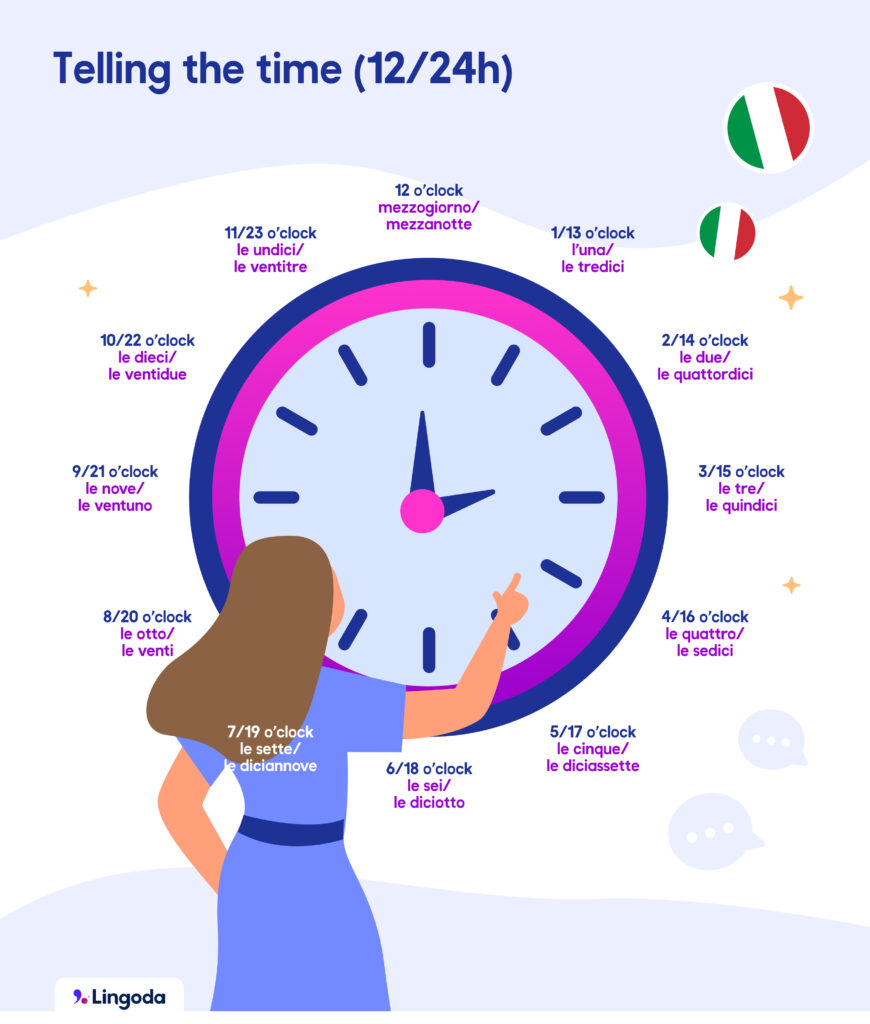How to tell the time in Italian

In Italy, time dictates the flow of daily activities, from business meetings to family dinners. Knowing how to express it correctly can make a huge difference in your interactions. For travelers, being able to read train schedules or know when museums open can save both time and stress. And though Italians aren’t always known for their punctuality, it remains important in the workplace, where understanding the official 24-hour clock system will keep you on track.
- How to ask the time in Italian
- How to tell the time in Italian
- Key vocabulary for time expressions
- How to use prepositions with time in Italian
- Cultural insights: Time-telling in Italy
- How to practice telling time in Italian
- FAQs
How to ask the time in Italian
Common phrases to ask for the time
Phrases commonly used to ask for the time in Italian include:
- Che ora è? (What time is it?)
- Che ore sono? (What time is it?)
- Hai l'ora? (Do you have the time?)
- Sai/sa che ora è? (Do you know what time it is?)
- Mi sai/sa dire che ore sono? (Can you tell me what time it is?)
- Puoi/può dirmi che ora è? (Can you tell me what time it is?)
Asking about specific times for events
- A che ora inizia la lezione? (At what time does the lesson start?)
- Quando parte il treno? (When does the train depart?)
- Sai a che ora è la cena? (Do you know what time dinner is?)
You may have noticed that some of the examples above include two variations (puoi vs. può, for instance). Using the formal conjugation (e.g. può) and more courteous synonyms for certain verbs will help you sound more polite. Here are some additional examples of formal addresses:
- Mi scusi, a che ora inizia la cerimonia? (Excuse me, at what time does the ceremony begin?)
- Può dirmi quando inizia il concerto? (Can you tell me when the concert starts?)
- Quando si svolge la cerimonia? (When does the ceremony take place?)
- A che ora è previsto l'arrivo dell'aereo? (What time is the plane expected to arrive?)

Learn Italian with Lingoda
How it works

How to tell the time in Italian
Telling the time on the hour
When telling the time in Italian on the hour, the structure is quite simple. For one o’clock, we use è, the singular form of the verb essere. For the rest of the hours, we use sono lei, the plural form of essere.
- È l’una. (It’s 1 o’clock.)
- Sono le dieci. (It’s 10 o’clock.)
- Sono le tredici. (It’s 1 p.m. — 13:00 in the 24-hour format)
Minutes after and before the hour
Hours always precede minutes when telling the time in Italian. For minutes after the hour, we use e (and), whereas for minutes before the hour, we use meno (minus). Translated literally, it would sound like, “It’s five and ten” (i.e. 5:10), or, “It’s six minus a quarter” (i.e. 5:45).
- Sono le cinque e dieci. (It’s ten past five.)
- Sono le sette e venti. (It’s twenty past seven.)
- Sono le tre e mezzo. (It’s half past three.)
- Sono le sei meno un quarto. (It’s quarter to six.)
- Sono le otto meno cinque. (It’s five to eight.)
- Sono le nove meno dieci. (It’s ten to nine.)

Key vocabulary for time expressions
| Italian | Pronunciation | English |
| mezzogiorno | met-soh-JOR-noh | noon |
| mezzanotte | met-sah-NOT-teh | midnight |
| mattina | mat-TEE-nah | morning |
| pomeriggio | poh-meh-REE-joh | afternoon |
| sera | SEH-rah | evening |
| notte | NOT-teh | night |
| ora | OH-rah | hour |
| minuto | mee-NOO-toh | minute |
| secondo | seh-KON-doh | second |
| orologio | oh-RO-loh-djoh | clock, watch |
| tempo | TEM-poh | time |
| quarto | KWAR-toh | quarter (15 minutes) |
| mezzo | MET-soh | half (30 minutes) |
How to use prepositions with time in Italian
Italian employs a few key prepositions to express time-related concepts:
- a (at) is used for specific times of the day or events.
- in (in) is used for Italian months, seasons, years and longer periods.
- da (since/from) is used for starting points in time (from a specific moment onward).
- per (for) is used to express a duration of time.
- tra (in/after) indicates something happened in or after a certain amount of time.
- fra (in/within) indicates something happened between two moments or events.
Common prepositional phrases
| Italian | Pronunciation | English |
| a mezzogiorno | ah met-soh-JOR-noh | at noon |
| a le tre | ah leh TREH | at three o’clock |
| in gennaio | in jen-NAH-yoh | in January |
| in estate | in es-TAH-teh | in summer |
| in 2023 | in doo-eh-mee-lah-ven-tee-TREH | in 2023 |
| da ieri | da yeh-ree | since yesterday |
| da lunedì | da loo-NEH-dee | from Monday |
| per due settimane | per DOO-eh set-tee-MAH-neh | for two weeks |
| per un’ora | per un-OH-rah | for an hour |
| tra venti minuti | trah VEN-tee mee-NOO-tee | in 20 minutes |
| fra due giorni | frah DOO-eh JOR-nee | in two days |
Cultural insights: Time-telling in Italy
The 24-hour clock vs. 12-hour time
In Italy (as in most of Europe), the 24-hour clock is commonly used in formal contexts such as transportation schedules, business hours and official events. For instance, a train might depart at 15:30 instead of at 3:30 p.m.
But in daily conversation, Italians often opt for 12-hour time with expressions like di mattina (in the morning), di pomeriggio (in the afternoon), di sera (in the evening) and di notte (at night). Understanding both systems is essential for smooth communication in Italy.
The singular vs. plural twist: What makes Italian time-telling unique?
Italian time-telling uniquely distinguishes between singular and plural forms based on the number of hours.
For 1 o’clock, noon and midnight, Italians use the singular form è, because these moments are considered individual events. Noon and midnight are distinct moments, while 1 o’clock is, well, only one!
For all other times, the plural form sono is used (Sono le cinque, i.e. “It's 5 o’clock”), reflecting the view that time consists of multiple hours, each collectively contributing to the day. This structure highlights the Italian perception of time as a flowing series of moments rather than isolated events.
Fun idioms and expressions about time
In Italy, time isn’t just a concept, but a language all its own. Whether rushing through the day or relaxing over a long espresso, Italians have a knack for weaving time-related idioms into their everyday conversations. Here's a list of some time-related expressions you might hear:
- Il tempo è denaro. (Time is money.)
- Arrivare in orario. (To arrive on time.)
- Tempo al tempo. (Time will tell.)
- In un batter d'occhio. (In the blink of an eye.)
- Chi va piano va sano e va lontano. (Slow and steady wins the race.)
- Ogni cosa a suo tempo. (Everything in its own time.)
- Fare le ore piccole. (To make it to the small hours, i.e. to stay up late.)
- A tempo debito. (At the right time.)
- Prendere il tempo giusto. (To take the right moment.)
- Perdere il tempo. (To waste time.)
How to practice telling time in Italian
Practicing how to say the time in Italian is both fun and practical. Start with the basics of Italian numbers, as they're the building blocks for telling time. Once you've got that down, try listening to Italian train announcements or the news. Both are full of time-related expressions and will help you tune your ear to the rhythm of how time is expressed.
Another great recommendation is, of course, to work with Lingoda tutors. Our professional instructors can guide you through specific time-related phrases and help you build the confidence to talk about time naturally!
What is the Italian term for ‘time’?
Tempo refers generally to the concept of time in Italian. More specifically, ora is used when talking about a schedule or clock time.
How to answer 'a che ora?'
To answer the question, “A che ora?” (At what time?), you can say:
- Alle + any number except one (Alle tre — At three o’clock)
- All’ + the number one (All’una — At one o’clock)
- A + noon or midnight (A mezzogiorno — At noon)
How do you say 7 p.m. in Italian?
To say 7 p.m. in Italian, you would use the phrase, “Le sette di sera.”
Time to start speaking Italian!
Mastering time in Italian isn’t just about knowing when your train leaves — it’s a gateway to understanding Italian life. Whether it’s reading the 24-hour clock or discussing evening plans with friends, knowing how to tell time in Italian is essential for travel, work and daily living. We’ve shared some tips to help you get confident, but in the end, enrolling in one of the best online Italian courses with Lingoda is the best advice we have for you. Lingoda can help you progress by speaking real-life language in small groups, led by native-level teachers who can guarantee you’ll learn to speak with confidence from day one.

Learn Italian with Lingoda
How it works

















